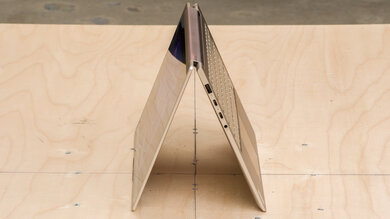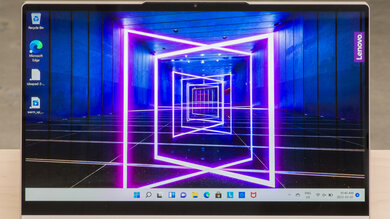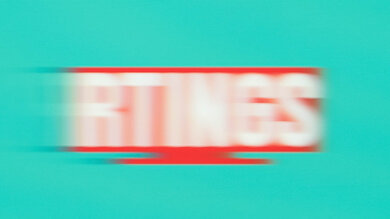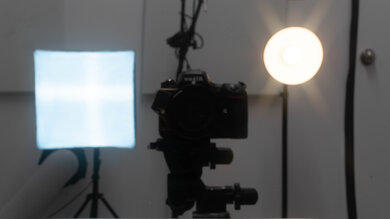The Lenovo Yoga 9i 14 (2021) is a high-end Windows 2-in-1 convertible laptop. It's available with an Intel 11th Gen Core i5 or i7 CPU, integrated graphics, and up to 16GB of memory and 1TB of storage. There are two display options: an FHD (1920 x 1080) and a 4k (3840 x 2160) IPS display. It has an island-style keyboard, a glass touchpad, a 720p webcam, and Wi-Fi 6 wireless connectivity. Ports include one USB-A, two USB-C/Thunderbolt 4s, and a 3.5mm headphone jack.
This laptop comes in two colors, Mica and Shadow Black. The latter has a slightly different design: it has a leather-clad lid, and the entire lower portion of the keyboard deck is glass. It also has a haptic touchpad and an ultrasonic fingerprint reader, whereas the Mica model uses a traditional touchpad with mechanical buttons and a capacitive fingerprint sensor. You can see our unit's specifications and the available configuration options in the Differences Between Variants section below.
Our Verdict
The Lenovo Yoga 9i is good for school use. It has an aluminum chassis that feels well-built, and it's very portable as it's thin and light. The display is sharp and provides enough space for multitasking, and the keyboard feels comfortable to type on for extended periods. Although its nine-hour battery life is enough to get you through a typical school day of light productivity, you may have to plug it in for a quick charge if you run more demanding applications. Its Intel 11th Gen CPU and integrated GPU can handle light workloads like text formatting and web browsing; however, they aren't ideal for intensive tasks like graphic design or 3D animation.
- Thin and light design makes it very portable.
- Battery lasts 9 hours of light productivity.
- Keyboard feels comfortable to type on for extended periods.
- Can use in tent or tablet mode.
- Pen included for taking notes.
- Low-power CPU and integrated GPU can't handle demanding workloads.
- CPU and GPU throttle under load.
- Screen doesn't handle bright reflections well.
The Lenovo Yoga 9i is inadequate for gaming. Although its Intel 11th Gen CPU is fairly capable, its integrated GPU isn't powerful enough to provide smooth gameplay in graphically demanding AAA games. You can play some lighter or older titles, but you'll have to play at the lowest settings or 720p to get reasonable frame rates. Also, it has a 60Hz display with a slow response and no VRR support to reduce screen tearing.
- Keyboard feels comfortable to type on for extended periods.
- Quiet fans under load.
- Low-power CPU and integrated GPU can't handle demanding workloads.
- CPU and GPU throttle under load.
- 60Hz display with slow response time and no VRR.
The Lenovo Yoga 9i is good for media consumption. It's compact and easy to carry around, and as it's a 2-in-1 convertible with a 360-degree hinge, you can put it in tent mode when viewing content or use it as a tablet. The battery lasts nearly 6 hours of video playback, giving you enough time to get through a couple of full-length movies. It has outstanding speakers that sound clear and well-balanced and get very loud. The screen is sharp and colorful; however, its glossy finish doesn't handle bright reflections well, and while its contrast is great for an IPS panel, blacks still look gray in dim settings.
- Thin and light design makes it very portable.
- Can use in tent or tablet mode.
- Loud and well-balanced speakers.
- Sharp and colorful screen.
- Blacks look gray in dim settings.
- Screen doesn't handle bright reflections well.
The Lenovo Yoga 9i is okay as a workstation. Its Intel 11th Gen CPU performs well but throttles significantly under load, which isn't ideal for heavy and sustained workloads. Also, its integrated graphics can't handle demanding tasks like video editing and 3D animation, and you can only configure the laptop with a maximum of 16GB of memory. On the upside, it has a fast SSD for quick file transfers, and its USB-C ports support Thunderbolt 4.
- Keyboard feels comfortable to type on for extended periods.
- USB-C ports support Thunderbolt 4.
- Quiet fans under load.
- Low-power CPU and integrated GPU can't handle demanding workloads.
- CPU and GPU throttle under load.
- Memory isn't user-upgradeable.
The Lenovo Yoga 9i is good for business use. It's a well-built, portable laptop with a sharp display and a comfortable keyboard. Its Intel 11th Gen CPU can easily handle most tasks like text formatting, web browsing, and spreadsheets. The battery lasts about nine hours of light productivity, so depending on your workload, you may have to plug it in for a quick charge to get through the day. Unfortunately, the webcam's video quality is mediocre as the image looks soft and underexposed, and it doesn't have an HDMI port, so you'll need an adapter if you want to connect to an external display like a TV or projector for presentations.
- Thin and light design makes it very portable.
- Battery lasts 9 hours of light productivity.
- Keyboard feels comfortable to type on for extended periods.
- Can use in tent or tablet mode.
- Low-power CPU and integrated GPU can't handle demanding workloads.
- No HDMI port.
- Screen doesn't handle bright reflections well.
Changelog
- Updated Jun 21, 2023: We've updated the review to improve clarity and readability.
- Updated Mar 16, 2023: Added mention of the Dell XPS 13 Plus (2022) as an alternative with an OLED display in the Contrast section.
- Updated Nov 02, 2022: Added mention of the Framework Laptop (2022) in the serviceability section as an alternative.
- Updated Mar 29, 2022: Review published.
Differences Between Sizes And Variants
We tested the Lenovo Yoga 9i 2-in-1 (model 82BG009XUS) with an Intel Core i7-1195G7 CPU, integrated Intel Xe Graphics, 8GB of memory, and 512GB of storage. The CPU, memory, and storage are configurable; you can see the available options in the table below. Our review applies only to variants with a model number starting with '82BG'.
| Screen |
|
| CPU |
|
| GPU |
|
| Memory |
|
| Storage |
|
| Color |
|
You can see our unit's label here.
Popular Laptop Comparisons
The Lenovo Yoga 9i is one of the best 2-in-1 convertible laptops on the market. It feels very well-built and provides a great user experience with a bright display, a comfortable keyboard, and outstanding speakers. However, like most ultraportables, its memory isn't user-replaceable, and its CPU throttles significantly under load.
For more options, check out our recommendations for the best business laptops, the best 2-in-1 laptops, and the best Windows laptops.
The Lenovo Yoga 9i 14 (2021) is essentially a more premium model of the Lenovo Yoga 7i 14 (2021). The 9i has a sturdier build, a better display with higher contrast and brightness, and much better-sounding speakers. The 9i has a 4k panel option, but it might not be worth it as the difference is hard to notice at normal viewing distances, and it significantly shortens battery life. As for the keyboard's typing experience, the 9i's keys require a bit more force to actuate, but they're more tactile and don't feel as mushy as the 7i's. The 7i has much better battery life as it lasts over 6 hours longer in a light productivity workload than the 9i.
The Lenovo Yoga 9i 14 (2021) and the HP ENVY x360 13 (2020) are very similar 2-in-1 convertible laptops with a 360-degree hinge. Both laptops have various display options; the Yoga 9i is available with a 1080p or 4k panel, while the ENVY x360 has multiple options, including a 1080p OLED and an IPS panel with 1000 cd/m² brightness. The Yoga 9i has much better speakers as they're louder and sound more well-balanced, whereas the ENVY x360 sounds treble-heavy and unnatural. On the other hand, the ENVY x360 has longer battery life, especially for video playback, and its CPU doesn't throttle as much under load.
Although the Lenovo yoga 9i 14 (2021) and the Apple MacBook Air 13 (M1, 2020) are both ultraportable laptops, they have very different features. The Lenovo is a 2-in-1 convertible that runs Windows, whereas the Apple is a traditional clamshell laptop that runs macOS. The Apple has a sturdier build, a much bigger touchpad with better tracking, and a webcam that captures a more detailed image for video calls. However, the Lenovo has a better port selection that includes two Thunderbolt 4 ports, better-sounding speakers, and a more comfortable keyboard to type on. The Apple laptop has significantly longer battery life, lasting a little over 3 hours in light productivity workloads. The Lenovo laptop's fans don't get very loud under load, but the Apple is quieter still because it's fanless.
The Lenovo Yoga 9i 14 (2021) and the Lenovo IdeaPad Flex 5 14 (2020) are both 2-in-1 convertible laptops with a 360-degree hinge and a 14-inch screen. The Yoga 9i is a more premium device that provides a better user experience with a brighter and more colorful display, including a 4k panel option, as well as better-sounding speakers and Thunderbolt 4 support. The Yoga 9i's Intel 11th Gen processors are faster than the IdeaPad Flex 5's AMD Ryzen 4000 and Intel 10th Gen CPUs; however, the Yoga 9i throttles significantly under load, while the IdeaPad Flex 5 can maintain its full performance in long and demanding workloads. The IdeaPad Flex 5 also has longer battery life, especially for video playback.
Test Results

The Lenovo Yoga 9i has a sleek and modern design, thin bezels on three sides, and a slightly thicker bottom chin. It has a small lip at the top border so that there's enough room for the camera, and it also provides a place to hold onto when opening the laptop. It's a 2-in-1 convertible with a 360-degree hinge, meaning you can flip the screen into tent mode for presentations or use it as a tablet. The hinge also houses the speakers, so they fire directly at you in clamshell mode but sideways in tablet mode.
The Lenovo Yoga 9i is available in two color schemes: Mica and Shadow Black. However, the Shadow Black model is different in design as it has a leather-clad lid, and the entire bottom row of its keyboard deck is glass. The Shadow Black model also has a haptic touchpad and an ultrasonic fingerprint reader, whereas the Mica model uses a traditional touchpad with mechanical buttons and a capacitive fingerprint sensor.
The build quality is great. It has a full aluminum chassis that feels sturdy and rigid, exhibiting only a tiny amount of flex in the display and keyboard. The Mica model doesn't pick up fingerprints easily, but according to most online feedback, the Shadow Black model does. Aside from the glass row on the keyboard deck, the Shadow Black model is also aluminum, including the lid underneath the leather.
The serviceability is disappointing. To access the internals, remove the rubber strips and the six T5 screws hidden underneath, then use a pick or prying tool to release the plastic clips holding the bottom panel. Unfortunately, only the M.2 SSD and battery are user-replaceable. If you want a laptop with better serviceability, check out the Framework Laptop 13 (2022).
The Lenovo Yoga 9i is available with the following displays:
- 14" IPS 1920 x 1080 60Hz Touchscreen
- 14" IPS 3840 x 2160 60Hz Touchscreen
While the 1080p resolution seems low compared to other premium laptops like the Apple MacBook Pro 14 (2021) or Microsoft Surface Laptop 5 (2022), images and text still look sharp as the pixel density is high. The 4k panel looks sharper as it has a higher pixel density of 315 PPI; however, the difference is hard to notice at normal viewing distances, and the increased resolution also shortens the battery life significantly. A 16:9 aspect ratio is great for media consumption since most videos are in that format, but a taller 16:10 or 3:2 would have been better for productivity, as it allows you to see more information at once, reducing the need to scroll. Also, it would have made the device feel less narrow when using it as a tablet in portrait mode.
The Lenovo 9i has a basic refresh rate typical of most thin, light productivity-focused laptops. The response time is very slow, causing a long blur trail behind moving objects, which isn't ideal for gaming or viewing fast content like sports. Its slow response time makes scrolling through a document or website look blurry.
The Lenovo Yoga 9i has a great contrast ratio. It still can't produce the deep blacks that VA and OLED panels can, but this is about as good as it gets as far as IPS panels go. Check out the Dell XPS 13 Plus (2022) if you want a laptop with an OLED display.
The display gets bright enough for use in most indoor settings but not in direct sunlight or outdoors in broad daylight. If you like working or viewing content in the dark, it gets dim at the lowest brightness setting to provide a more comfortable viewing experience. The 4k panel has an advertised brightness of 500 cd/m², which is enough for outdoor use.
The reflection handling is mediocre. Its glossy finish has no issues with bright ambient lighting but struggles with direct reflections like a lamp or a window in broad daylight. The reflections make it near impossible to see dark content and are visible even with the screen at maximum brightness.
The display's horizontal viewing angle is decent. The image looks dimmer and washed out from the side. You can still share the screen with someone else for text documents and other casual content, but it's best to be directly in front of the screen if you need perfect accuracy for color-critical work.
The vertical viewing angle is okay. You can look at the screen from slightly above or below without losing too much accuracy, which comes in handy in tight spaces that force you to look at the screen at an angle, like on a bus or airplane. It's best to look at the screen straight on if you need perfect image accuracy.
The Lenovo Yoga 9i's display accuracy is sub-par out of the box. Most color inaccuracies are minor and hard to spot, but the white balance is visibly off. The color temperature is on the cooler side, giving the image a slightly bluish tint. The gamma doesn't follow the sRGB curve, causing dark scenes to appear darker than they should while over-brightening bright scenes.
The Lenovo Yoga 9i has a great color gamut. It's mainly an sRGB panel as it's the only color space it covers fully. It doesn't have enough coverage of the wider color spaces like Adobe RGB, DCI P3, and Rec. 2020 for practical purposes. It's suitable for content creators working in sRGB, but it isn't ideal for producing and viewing HDR content or photo editing. If you want to view more vibrant colors in HDR, it's best to get the 4k panel, as it has an advertised 90% DCI P3 coverage.
The Lenovo Yoga 9i has a great keyboard. The keys are of a good size and stable, with sufficient spacing between them, and the layout is standard and easy to adapt to. The keycaps feel high-quality but not as good as other premium laptops like Apple MacBooks. The keys have a lot of travel and tactility, and although they require a fair amount of force to actuate, they don't feel tiring to type on for extended periods. You can toggle between two backlight brightness levels or turn it off completely using FN and the spacebar.
The Lenovo Yoga 9i has a decent touchpad. It's reasonably large and has a smooth surface that makes it easy to glide around. It tracks all movements and gestures well, and there aren't any issues with palm rejection or actions like dragging and dropping. The clicking mechanism feels satisfying, but it only works in the bottom half of the touchpad. Unlike the Mica model, which uses mechanical buttons, the Shadow Black model uses haptic feedback to simulate the click, meaning it likely has a larger clickable surface.
The Lenovo Yoga 9i has outstanding speakers. Lenovo integrated them into the hinge to fire directly at you in clamshell mode but sideways in tablet mode. They sound clear, natural, and well-balanced; however, they don't have enough bass extension to produce rumble or thump in music and movies. They get very loud with minimal compression artifacts at max volume.
The webcam's video quality is mediocre. The colors look natural and accurate; however, the overall image looks slightly underexposed and lacks fine detail due to the low resolution and noise. Voices come across clearly but sound slightly hollow and nasal with a little too much bass. The physical privacy cover disables the camera and microphones at the software level.
The Lenovo Yoga 9i has a good port selection. The USB-A port supports USB 3.2 Gen 1 data transfer speed (up to 5Gbps). The two USB-C ports support Thunderbolt 4 (up to 40Gbps data transfer speed and video output to two 4k displays at 60Hz) and Power Delivery 3.0. The latter allows for fast charging of the laptop and other PD-compatible devices connected to the port. The USB-C ports are always on, meaning you can use them to charge another device even when the laptop is in sleep mode.
The wireless adapter is an Intel Wi-Fi AX201.
The Lenovo Yoga 9i is available with the following CPUs:
- Intel Core i5-1135G7 (4 cores/8 threads, up to 4.2GHz, 8MB)
- Intel Core i5-1155G7 (4 cores/8 threads, up to 4.5GHz, 8MB)
- Intel Core i7-1185G7 (4 cores/8 threads, up to 4.8GHz, 12MB)
- Intel Core i7-1195G7 (4 cores/ 8 threads, 5.0GHz, 12MB)
All four are low-power CPUs designed for light workloads like web browsing, text formatting, spreadsheets, and other general productivity tasks. They can handle more demanding tasks like photo editing if the material isn't overly complex. There isn't much performance difference between the two Core i5s and the two Core i7s, as the higher-number SKUs are simply better parts that run at slightly higher clock speeds. The Core i7s are faster than the Core i5s, but only in bursts, as the Core i5s will likely run cooler and maintain their full performance for longer in sustained workloads.
Note: You can only get the Shadow Black model with a Core i7 CPU.
The Lenovo Yoga 9i uses the Intel CPU's integrated Iris Xe Graphics. The Core i5s have 80 execution units, while the Core i7s have 96. The Core i7s will perform slightly better, but not enough to make much difference in most graphically-intensive applications or games. Intel's Iris Xe is among the better-integrated GPUs in its generation; however, it's still a low-power graphics processor that can only handle simple tasks, not graphically intense workloads like AAA gaming or video editing.
You can configure this laptop with 8GB or 16GB of memory. 8GB is enough for most people with light workloads; however, upgrading to 16GB might be worth it to help avoid slowdowns when multitasking heavily and make the laptop more future-proof. Also, the memory isn't user-upgradeable, so you can't add more later.
You can configure this laptop with a 256GB, 512GB, or 1TB PCIe NVMe SSD. The SSD is user-replaceable; the slot supports M.2 2280 PCIe Gen 3 x4 NVMe SSDs.
The Lenovo Yoga 9i has a great overall score in Geekbench 5. Its single-thread performance is outstanding and among the best for x86 CPUs of its generation, with only Apple's M1 SoC being slightly faster. Its multi-thread performance is very good for a CPU with 4 cores and 8 threads, but if you need to run heavily multi-threaded programs for your work, it's best to get an H-series processor like the Intel Core i5-11400H in the HP Victus 16 (2021) or Apple's M1 Pro and Max SoC they have more cores and threads to provide a smoother experience.
In short, the Intel i7-1195G7 can easily handle most general productivity tasks like web browsing, text formatting, and spreadsheets. It's a fairly capable CPU that can handle more demanding tasks; it just isn't ideal for heavy, sustained workloads due to thermal throttling. You can get slightly better performance in the Performance mode, as the results above are benchmark scores obtained in the default Balanced power profile. However, the performance gain is minimal and comes at the cost of higher CPU and GPU temperatures and louder fan noise. The other CPU options will perform only slightly worse. As for GPU compute tasks, Intel's Iris Xe is better than most integrated GPUs, but it's still a relatively low score. You can get much better performance with even an entry-level dedicated GPU like an NVIDIA GeForce GTX 1650.
The Lenovo Yoga 9i has a great overall score in Cinebench R23. Like in Geekbench 5, the Intel i7-1195G7's single-thread performance is outstanding and among the best for CPUs of its generation. However, its multi-thread performance is only decent due to its limited number of cores and threads and thermal throttling. For professional-level rendering or other related tasks, it's best to go with a CPU that has more cores and threads and in a laptop with better cooling so that the CPU can maintain its full performance over an extended period.
The Lenovo Yoga 9i performs poorly in Blender. It takes a long time to render the simple bmw27 scene, which isn't ideal for professionals working on a deadline. The integrated GPU completes the task faster, but it isn't enough to make much difference. The other CPU options will be even slower.
The Lenovo 9i performs poorly in the Basemark GPU benchmark. It has a good score for integrated graphics but is still far behind even entry-level dedicated GPUs. You can play some light puzzle-like games that aren't graphically demanding, though you'll have to play at low settings or 720p to get playable frame rates.
The storage drive performance is outstanding. It has fast sequential and random read and write speeds, allowing the system to boot up, launch apps, and quickly transfer files. There are SSDs with faster sequential speeds, like the Apple MacBook Pro 14 (2021)'s, but the Yoga 9i's SSD is fast enough if you only perform general productivity tasks and don't transfer large files regularly. Also, the storage drive is user-replaceable, meaning you can swap it out for a faster one later. The speed of the SSD may vary depending on the size, as larger SSDs tend to perform better.
The battery life is decent. It lasts long enough to get you through a typical 8-hour day of light productivity tasks, but just barely, so you may have to plug it in at some point for a quick charge. Video playback consumes more power; however, you can still comfortably get through a couple of full-length movies. Although the battery life is very short when gaming or performing demanding tasks, it's still very good compared to gaming laptops or mobile workstations with a dedicated GPU. According to most online feedback, models with the 4k panel have shorter battery life, lasting around 7 hours of light productivity.
Borderlands 3 isn't playable. The game is extremely choppy, even at the lowest graphical settings. None of the configurations can run this game smoothly.
Civilization VI runs poorly on the Lenovo Yoga 9i. It's a bit choppy at high settings, but since it's a turn-based game that's very playable at 30 fps, you only need to turn down a few settings to get there. That said, the turn time is very long. The Core i5s will perform slightly worse; they're in the same ballpark as the Core i5-1135G7 in the Lenovo Yoga 7i 14 (2021).
The Lenovo Yoga 9i's performance in CS:GO is disappointing. The average frame rate at high settings is decent, but the game stutters a lot. You can get smoother gameplay if you turn down some settings, though you'll still experience stutters, which isn't ideal for an FPS game. The Core i5s will perform slightly worse.
Shadow of the Tomb Raider isn't playable. The game is very choppy and occasionally freezes with high graphical settings; it doesn't get much better with low settings. None of the configurations can run this game smoothly.
The Lenovo Yoga 9i has good thermal and noise handling. The keyboard is just slightly warm when idle, and the fans are only audible if you put your ears right next to the laptop. The keyboard gets toasty under load, but it still isn't uncomfortable, and the hottest spot is near the top of the keyboard, away from where most people rest their hands. The fans remain relatively quiet under load, though it's worth noting that this is in the Balanced power profile. They're louder if you switch to Performance mode. Even then, it's mostly the sound of heavy airflow, not an annoying high-pitch whine.
The Lenovo Yoga 9i has poor performance over time. Both the CPU and GPU throttle under load even though their temperatures are relatively low. The CPU's performance drops significantly, and it takes a while to recover, likely to keep fan noise low. The throttling only happens in demanding tasks that push CPU and GPU utilization to near 100%, so you won't experience it if you have a light workload. The other CPUs will likely throttle less.
Depending on the model and manufacturing date, the Lenovo Yoga 9i 14 comes with Windows 10 or 11 and can be either the Home or Pro version. There are many pre-installed software applications, including:
- Alexa: Amazon's digital assistant. This is only available in select regions.
- Dolby Atmos Speaker System: Settings for the built-in speaker system.
- Dolby Vision: Adds Dolby Vision support and lets you change the picture mode.
- Glance by Mirametrix: Software application that adds attention sensing capability. When enabled, it can automatically lock your computer when you walk away, pause a video or blur the content when you aren't directly looking at the screen, or move windows from one screen to another.
- Lenovo Hotkeys: Lets you create keyboard macros.
- Lenovo Pen Settings: Lets you access customization settings for the included stylus.
- Lenovo Vantage: This app helps keep the drivers and BIOS up to date. It lets you view the system's status and warranty information and access various settings, like power and audio profiles.
- Lenovo Voice: Text-to-speech application.
- Lenovo Welcome: Contains general information about the laptop for new users.
- McAfee LiveSafe: Antivirus software.
- Smart Microphone Settings: Lets you access various settings for the built-in microphones, like echo cancelation and keystroke suppression.
- SmartNote: Note taking app.
- Spotify: App for music streaming service.
The Lenovo Yoga 9i 14 has a fingerprint sensor on the right side of the keyboard deck, below the right arrow key. You can use it to log into Windows, authorize purchases on the Windows Store, or auto-fill your credentials on supported websites. The Shadow Black model with a leather-covered top has an ultrasonic fingerprint sensor, while the Mica model has a capacitive sensor. Ultrasonic sensors are generally more secure than capacitive ones and work better with wet or oily hands. However, they don't perform as reliably with very dry hands.
The Lenovo Yoga 9i supports pen input and comes with an active stylus. The stylus has a built-in rechargeable battery, which Lenovo says will last up to 130 hours, and you can charge it by putting it back into its dock at the right backside of the laptop. The stylus uses Wacom AES pen technology, meaning any third-party Wacom AES stylus will work. Regarding the user experience, the pen tracks well and has very low latency, and there aren't any issues with palm rejection. It feels more like writing on glass than paper, but there's still some friction. Although it supports up to 4096 levels of pressure sensitivity, it doesn't support tilt, so it's better suited for note-taking and quick scribbles than actual drawing. Also, the slimness of the pen makes it uncomfortable to use for extended periods, especially for people with big hands.


































